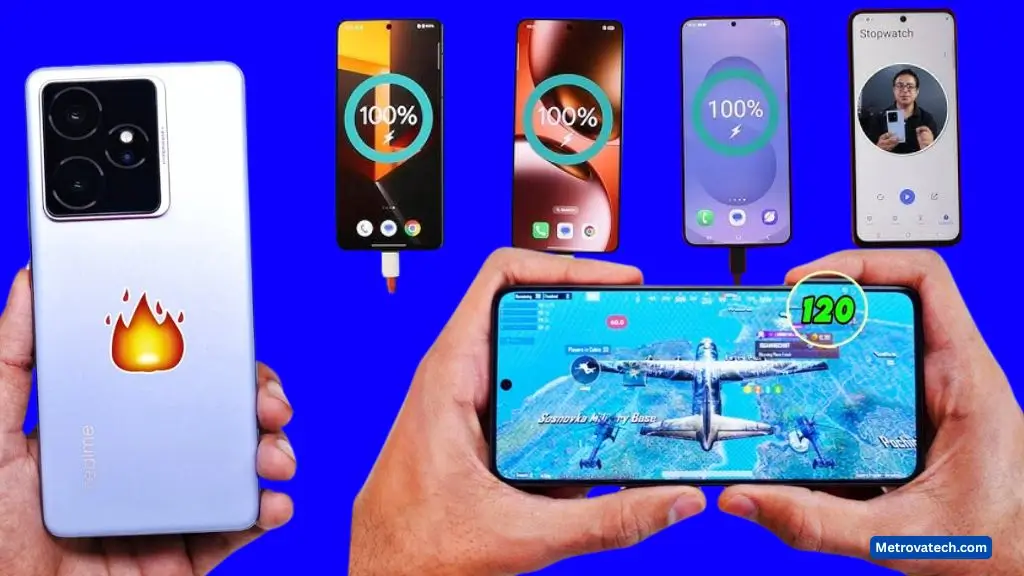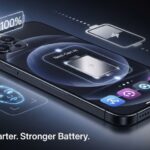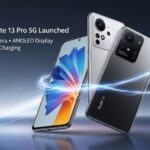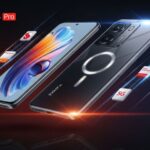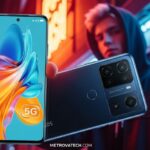The GT 7 by Realme has a lot of power not only in its hood but also in its battery box. After the recent update to the phone software, I enjoyed it on quality time with daily activities, intense gaming, video streaming, and idle usage. In case you want to have actual values of battery backup, idle drain, BGMI gaming data, and charging speed, you have arrived at the right place. I am going to tell you along the way about the both better and worst features, it will be simple for you to figure out whether the Realme GT 7 is your type.
Realme GT 7: Best Battery and Charging Overview
Realme GT 7 leaves the competition far behind in two major areas – an uninterrupted chipset and a mammoth battery. This is what you are rewarded with:
- 7000 mAh battery: By far, one of the maximum in its class. Designed to be used all day long and without stress. The 120W charger comes in the box: Realme also provides a super-fast charging brick and that is a relief. It is always difficult to charge large batteries fast.
Quick Take: Hardware at a Glance
- Chipset la MediaTek Dimensity 9300EE
- Battery: 7000mah
- In the box Fr: 120W Rapid Charger
Display Performance and Key Setting Adjustments
Realme GT 7 has a beautiful display. The phone has a modern LTPO panel with auto-refresh support between 1 Hz and 120 Hz. This adaptive moving truly assists achieve steadiness on the battery life. I tested this with Developer Options, and it does very well in switching between refresh rates when it requires it.
Before testing, here’s how I set up the phone for consistency:
- Respons mode: LTPO panel auto – refresh
- Brightness: It should be 75-80%
- Volume: Approximately 60 per cent
- Developer settings: Verified refresh rate (displays current value in real-time on the screen)
- Screen resolution: Standard mode of video tests to save the battery
- Light Mode: Activated in comfort of viewing a content
- Click on Setting.
- Hit about phone and turn on Developer Mode.
- Under Developer Options scroll down and find ‘Show refresh rate.’
BGMI Gaming Battery Test: Real Numbers and Experience
The actual test of battery and performance, for me it was, BGMI (Battlegrounds Mobile India). Here’s how I did things and what followed is:
- Connection: 5G (widely available) Dual SIM, Cellular Phone Part significantly used, main SIM line (game was played by using mobile data)
- Perfomace: Game settings Smooth + Ultra Extream (120fps). Some people may prefer to tweak further by using GT, Balance or Low Power, but as I saw no benefit I chose Balance Mode (GT Mode off).
- Display: Automatic refresh rate, brightness 75-80 percent; volume greater than 60 percent
- Background jobs: Shut all other things to concentrate on game drain
Gameplay Observations
- Original battery- 92%
- After 30 min , BGMI : 84 %
- Real drop: 8 percent in half an hour
Breakdown of BGMI Experience:
- There is butter-smooth TDM gaming at 120 fps. I did not see any lag or the frame drop. During classic games, I experienced some delays, but they were never persistent, they were just some stutter. After some intense gameplay, the phone became a little bit warm on its back with most of the heat on the upper half.
Game Settings Recap:
When you are on GT mode or other more aggressive options, the battery drops a tad steeper, but the phone does not even make a sweat when it has to run heavy-loaded graphics.
Battery Drop and Heating:
- 8% fall in 30-minute(n BGMI,120 fps)
- The very least warming in the back–noticeable, but not to be alarmed at
The graphene layer on the phone is supposed to assist it with warmth, but you may feel a bit of it on a hot summer day when you press on it hard.
- Video: You Tube 4K HDR video at 30 fps – 30 minutes
- Screen settings: Brightness on 70 percent (not auto)
- Sound: About 50 percent of volume
Results of Video Playback
- Initial battery: 81 %
- Rated battery: 76%
- Maximal fall: 5 per cent in half an hour
Content Viewing Impression:
- The screen is highly outlined and clear. HDR is vibrant and high on contrast.
- Everything is sharp and vivid even at 70 per cent brightness.
- The speakers are loud and can easily occupy a room. Nevertheless, it is a bit of lack of bass compared to some competitors, that can be known.
Video Experience: Pros and Cons
- Pros:
- High quality display
- Smooth hdr video
- Loudspeakers
- Cons:
- Bass is a bit poor in speeches
Idle Battery Drain and Real-Life Battery Usage
It is not just gaming and broadcasting. The phones also require a charge even when they are not in use. I did a real idle drain test to the Realme GT 7.
Idle Test Setup:
- No mobile data, Bluetooth, Wi-Fi, or hotspot
- Phone left untouched overnight
What happened:
- 12:00 AM: Battery at 31%
- 7:07 AM: Battery at 24%
- Drain: 7% over 7 hours idle
This high power of idle drain is somewhat excessive with the massive battery. I believe there should be a little adjustment to battery-optimization in Realme.
Real-World Daily Usage:
| Usage | Time Spent |
|---|---|
| YouTube | 4 hours |
| 1 hour 37 minutes | |
| BGMI Gaming | 33–34 minutes |
| Amazon, Chrome, Call of Duty, etc | Mixed usage |
- Screen On Time (SOT): 9:48 hours with complete charge to 21 per cent battery remaining
- Total usgage with results measurment: Circa 24 hours out off chargor
- Network: The whole test was carried out on mobile data, no Wi-Fi; a hotspot was utilized occasionally
The real battery backup may exceed 10 hours SOT with usage of phone round 0 to 100 percent.
Efficiency Notes:
- Apps that consume much power (such as games and video using mobile data) use more battery.
- High refresh rates and hotspots also boost the use.
120W Charging: Fast Real-World Results
Such a large battery requires a fast charger, and Realme does not disappoint because it ships with a 120W charger. So here is how charging turned out:
Charging Setup:
- Balance mode for battery , gt off
- A battery capacity of 100 percent
- The usage of Smart rapid charging made it possible
- Screen Off whilst charging.
Charging Milestones:
- Start-up : 20% batterie
- 10 minutes later: 52% (+32% ten minutes)
- 13 minutes to 21m 46s: increment in 80% (+60% in ~22 minutes)
- Full charge (20 percent to 100 percent): 53m 29s (+80 percent in 54 minutes
Charging from 0% instead of 20% would add maybe 5-6 extra minutes.
Charging Speed Takeaways
- Fastest from 20% to 80% slowest 80% to 100% It is normal since phones tend to charge a bit slower toward the end in order to preserve the health of the battery.
- To extend the life of the battery it should be left charging at between 20-80 percent.
- Display off accelerates the process of charging a lot.
Key Charging Stats to Know:
- 20-80% : ~22min
- 17% a 100%: ~ 54 minu.
It is a lifesaver charging speed in case you are always on the move.
Heating and Thermal Performance
There is some heat to be expected when you push the Realme GT 7. So here is what I discovered.
- In the course of gaming (BGMI, 120 fps, 5G) back panel slightly warmed up
- When charging, especially on higher rates, there is some sort of warmth
- Mild heating is also obtained by using demanding tasks (benchmarks, camera, outdoor gaming).
Realme sew a graphene layer at the colour purposes from the back, which need help. However in hot days Orr in heavy trading, will start to show heat.
Heat Behavior Highlights:
- Lightly warm after hard works.
- Apparent but not uncomfortable
- Maybemore in summer time
- Graphene does help, but its not a pixie dust
UI Quirks and Missing Features (Compared to GT6)
- I have found that on Realme GT 7, the display RAM information option is not available on the top tabs in recent apps/settings.
- RAM stats and a memory animation in the Realme GT6 are in, whereas the GT7 lacks this (not yet, at least).
- In future updates the GT 7 is likely to have the display RAM management features that exist in the GT6.
- This is a good thing since the auto refresh rate is very smooth and consistent.
Quick Comparison:
| Feature | Realme GT6 | Realme GT7 |
|---|---|---|
| Display RAM info | Yes | No |
| RAM animation | Yes | No |
| LTPO auto refresh rate | Yes | Yes (more consistent) |
Remember this distinction in case you appreciate obvious RAM statistics and effects.
